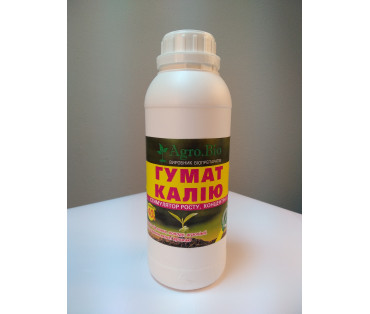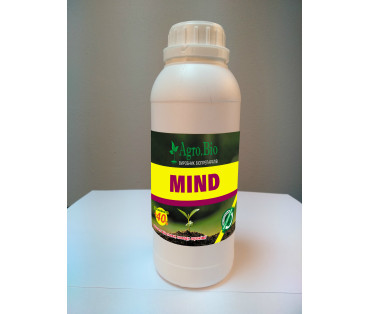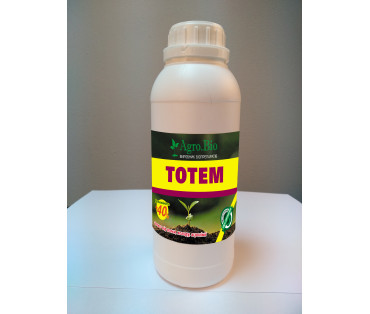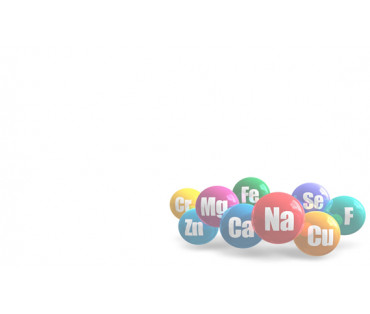On the influence of bitumens and vitamins on the vital activity of higher plants
The main task in the field of agriculture will continue to be to increase the yield of all agricultural crops. One of the factors contributing to the solution of this problem is the complete satisfaction of the needs of plants in nutrients. Usually, when they talk about plant nutrition, they mean only mineral nutrients. But this concept is not entirely correct.
Microbiologists have done much in the study of symbiotrophism in the life of higher plants and have firmly established the fact of the mutual influence of the soil microflora on the vital activity of plants and, conversely, of plants on the microflora. The question of how this mutual influence is carried out is still open.
Our previous work with potassium humate led us to a deep conviction that this most common product of soil microflora vital activity can be absorbed by plants and perform a certain physiological function in them and thereby increase the yield. But if any substance enters the plant, is included in the metabolism and performs some physiological function, as a result of which the accumulation of dry substances in plants increases, then there is every reason to say that it (this substance) takes part in plant nutrition.
One can hardly think that humic acid is an exception in this respect. It is more likely that other organic waste products of the soil microflora are also used by plants.
Consequently, in order to fully satisfy the needs of a plant in nutrients, it is not enough to talk about mineral nutrients; it is necessary to try to find at least the most important circle of those organic substances that are used by the plant in the process of nutrition and can be involved in increasing the yield of all agricultural crops. This short communication is devoted to this issue.
The composition of soil humus, in addition to the actual humic substances, also includes bitumen. Huge masses of bitumen are contained in caustobioliths - sapropel, carbonaceous and combustible shales and in spent gumbrine. All these caustobioliths could become an inexhaustible source of fertilizers if it were possible to prove the positive effect of bitumen on the growth of agricultural plants. Therefore, several experiments were carried out to study the effect of bitumen on the growth of crops.
In setting up these experiments, we proceeded from the following considerations. In previous works, we found that the physiological function of humate is mainly reduced to improving the oxygen supply of plants and, in connection with this, to the activation of metabolism. This is achieved by the fact that humic and fulvic acid, due to its chemical structure, performs the function of oxygenase and enhances the phenolase oxidative system. But oxidative metabolism in plants is carried out not only by the phenolase oxidative system. The cytochrome system, the system of flavin enzymes, and others function in plants and have different relative importance in the overall balance of oxidative metabolism depending on the plant species and the period of development.
Previously, it was found that different crops react differently to humate. It can be assumed that in those plants that do not react to humate, the main part of respiratory gas exchange is carried out with the help of other oxidative systems. It must be assumed that the same physiological effect can be achieved in these cultures by strengthening those oxidative systems that are leading for them.
Our past work has shown that oilseeds react poorly to humate. In these crops, the main type of reserve substances are fats. Since enzymatic systems are always oriented towards the type of metabolism that is unique to a given group of plants, it can be assumed that in this group of plants, oxygen supply is carried out with a greater participation of lipoxidase, and, therefore, the function of oxygenases should be performed by unsaturated fatty compounds. Logically, it can be assumed that bitumen can be used to enhance this enzymatic system, since it contains these compounds.
To test this assumption, we carried out experiments to study the absorption of oxygen by plant tissues of seedlings in the presence of gumbrin bitumen.
The bitumen for the experiment was prepared as follows: a weighed portion of gumbrin was extracted with alcohol in a Saxlet apparatus. Then, a small volume of the alcoholic extract thus obtained was mixed with a large volume of water.
After that, the alcohol was distilled off and the resulting emulsion was brought to its original volume. By subsequent dilutions, the desired concentration of bitumen was obtained (the initial titer was found from the weight loss of the gumbrin sample after extraction).
Alcohol was not introduced into the control distilled water, since at the dilutions that we used, even if the alcohol were not distilled off, its amount in one milliliter would be measured in the order of hundred-thousandths and millionths of a gram.
Oxygen uptake was determined in a Warburg gas meter. Experiments were carried out with mashed tissues of barley and flax seedlings. A portion of the pounded tissue was 0.5 g. The amount of liquid used to wash off the pounded tissue was 5 ml.
The results of the experiment are shown in table 1.
Table 1
The amount of O2 mm3 absorbed by one gram of plant tissue in 10 minutes
|
Added to pounded tissues
| Barley | Linen | ||
| leaves | roots | leaves | roots | |
| Distilled water | 40 | 118 | 370 | 210 |
| Bitumen gumbrin 0.42 mg per 1 liter | 44 | 204 | 380 | 1010 |
| Gumbrine bitumen 0.042 mg per 1 liter | 100 | 475 | 380 | 1470 |
In percentages (%)
| Distilled water | 100 | 100 | 100 | 100 |
| Bitumen gumbrin 0.42 mg per 1 liter | 110 | 172 | 103 | 408 |
| Gumbrine bitumen 0.042 mg per 1 liter | 250 | 440 | 103 | 700 |
It can be seen from the table that the presence of gumbrin bitumen enhances the oxygen uptake by plant tissues, and root tissues under the influence of bitumen absorb oxygen much more actively than tissues.
sheet. This fact indicates an increase in oxidative metabolism in plant tissues under the influence of bitumen, but does not allow us to say due to the strengthening of which enzymatic system this occurs. This question
should be the subject of further study.
To elucidate the physiological effect of gumbrin bitumen on plants, an experiment was carried out with seedlings of various cultures. In this experiment, an aqueous bitumen emulsion was introduced into distilled water, on which seedlings of various agricultural crops were then planted. The results of the experiment were taken into account by measuring the growth of roots and aerial parts of plants on the 15th day after laying.
With a decrease in the concentration of bitumen, its efficiency increases. The physiological effect caused by bitumen in different plants is different. In barley, gumbrin bitumen promotes the development of secondary roots, lengthens them, but does not lead to branching, as is the case with the use of humates. In flax, it enhances the growth of the aerial parts of the plant, lengthens and pubescent primary roots with second-order roots.
It is extremely important to note that if gumbrin bitumen is oxidized, then its physiological effect disappears. In addition to humates and bitumens, soil humus also contains other physiologically active organic substances, among which vitamins should be put in the first place. They accumulate in the soil also as a result of the vital activity of microflora. The relationship between the amount of vitamins and the bacterial population of the soil can be illustrated by the data given in Table 3.
Table 3
The amount of vitamins (in micrograms) per 100 g and bacteria per 1 g of soil
| The soil | Vitamin B 3 | Vitamin B 1 | Biotin | bacteria |
| Fertile (chernozem) | 980 | 4.5 | 45 | 150000000 |
| Infertile (podzol) | 50 | 1.2 | 2.5 | 500 000 |
These data indicate that in different soils there may be a different supply of vitamins, therefore, there is reason to assume that on soils poor in microflora, the plant lacks them.
Consider the question: how does the plant cope with the synthesis of vitamins? Different plants cope with the synthesis of vitamins in different ways. The leaves of green plants themselves synthesize vitamin molecules, but the roots, as a rule, need their influx from the outside. The roots of some crops, such as peas, can synthesize vitamin B1 from its two constituents, pyrimidine and thiazole. Tomato roots need only thiazole for the synthesis of vitamin B1.
At the same time, there are plant organisms that cannot synthesize this vitamin at all and need its ready-made molecule for their vital activity. Tobacco roots cannot synthesize vitamin B2 - riboflavin, clover, carrot, tomato, sunflower roots do not synthesize vitamin B6 - pyridoxine - and require the presence of vitamins C and B1 for their normal growth. The roots of peas, alfalfa, clover, sunflower and other crops need vitamin P-P - niacin. In addition, at different stages of development, plants do not synthesize vitamins equally intensively.
Our work with humates and bitumen showed that one of the most promising ways of influencing the metabolism in a plant and obtaining a certain physiological effect is the way of strengthening the system of redox ferrites. Therefore, we set up experiments with those vitamins that are used to build these enzymatic systems, namely: with vitamins B1, B2, C, PP, A and D.
Before testing how these vitamins affect plant growth, an experiment was set up in the Warburg apparatus to determine whether they affect oxygen uptake.
The experiment was carried out with mashed tissue of 2-week-old barley seedlings. The experimental procedure is the same as in the experiment with bitumen (the concentration of vitamins is 10 mg per 100 ml of water).
Vitamins enhance oxidative metabolism in plant tissues, and the roots react much more actively to the addition of vitamins. This confirms the idea that the root, as a heterotrophic organ, needs much more external supply of such vital substances as vitamins. Strengthening of gas exchange in plant leaves under the influence of vitamins was observed by us in the future.
So, in an experiment with infiltration of intact potato leaves with solutions of vitamins, it was found that the absorption of carbon dioxide after keeping these leaves in the dark around the clock increased as follows: with infiltration with vitamin B1 - by 32%, with vitamin P-P - by 5.5%, infiltration vitamin B2 did not affect the absorption of carbon dioxide.
Experiments with the effect of vitamins on plant growth were carried out with seedlings of various plants in distilled water without the addition of minerals. Measurements were taken on the 15th day of the experiment.
Solutions of fat-soluble vitamins were prepared according to the same principle as bitumen, i.e., fat-soluble vitamins were dissolved in alcohol, then the alcohol was mixed with water, after which it was distilled off. The resulting aqueous emulsions of vitamins were brought to a certain volume with water, and experiments were carried out with them.
| Experience Scheme | Above ground length | Length of roots | Roots of the 2nd order | |||
| primary | secondary | maximum | quantity | length, mm | ||
| Distilled water | 192 | 29 | 36 | 85 | no roots | no roots |
| Vitamin B 1 - 2 mg per 1 liter of water | 230 | 38 | 75 | 105 | 9 | 10 |
| Vitamin B 1 - 4 mg per 1 liter of water | 220 | 32 | 88 | 220 | 9 | 5 |
| Vitamin B 1 - 6 mg per 1 liter of water | 197 | 32 | 56 | 137 | 3 | 5 |
| Vitamin B 2 - 2 mg per 1 liter of water | 240 | 33 | 179 | 310 | no roots | no roots |
| Vitamin B 2 - 4 mg per 1 liter of water | 210 | 45 | 87 | 175 | ||
| Vitamin B 2 - 6 mg per 1 liter of water | 220 | 34 | 31 | 67 | 8 | 7 |
| Vitamin C - 4 mg per 1 liter of water | 250 | 35 | 53 | 76 | no roots | no roots |
| Vitamin C - 6 mg per 1 liter of water | 200 | 20 | 33 | 80 | ||
| Vitamin R-R - 2 mg per 1 liter of water | 220 | 40 | 150 | 330 | 17 | 20 |
| Vitamin R-R - 4 mg per 1 liter of water | 210 | 31 | 56 | 100 | no roots | no roots |
| Vitamin R-R - 6 mg per 1 liter of water | 196 | 37 | 27 | 60 | ||
From these data it can be seen that increasing the dosage of vitamins, as a rule, reduces their effectiveness and that all vitamins in optimal doses contributed to the development of secondary roots in barley. All tested vitamins had a much weaker effect on the development of above-ground organs. In order to reveal the influence of various vitamins on the development of individual species and varieties of grain crops, in the month of May we set up an experiment with seedlings of various plants. The same experience was repeated in June. Vitamins were introduced in optimal dosages. Water-soluble - at the rate of 2 mg per 1 liter of water, and fat-soluble - 2 human doses for the same amount of water.
Table 5
Effects of Different Dosages of Fat-Soluble Vitamins on Barley Growth
| Experience Scheme | The length of the above-ground part of plants, mm | Root length, mm |
Number of 2 orders | ||
| average |
maximum | ||||
| primary | secondary | ||||
| Distilled water | 155 | 56 | 7 | 20 | no roots |
| Vitamin A : | |||||
| 1 human dose per 1 liter of water | 183 | 52 | 32 | 42 |
no roots |
| 2 human doses per liter of water | 210 | 64 | 110 | 170 | |
| 4 human doses per liter of water | 171 | 48 | 32 | No data | |
| 6 human doses per 1 liter of water | 171 | 50 | 5 | No data | |
| Vitamin B : | |||||
| 1 human dose per 1 liter of water | 187 | 49 | 58 | 100 |
no roots |
| 2 human doses per liter of water | 190 | 57 | 103 | 175 | |
| 4 human doses per liter of water | 182 | 53 | 63 | No data | |
| 6 human doses per 1 liter of water | 134 | 49 | 14 | No data | |
Note. The concentration of fat-soluble vitamins is shown in human doses because they are produced by factories with such a dosage indicated.
The results of these experiments showed that different types and varieties of wheat react differently to vitamins and that the most important factor determining the response of plants to vitamins is the ambient temperature.
The experiment laid down in May proceeded at an average air temperature of 16.6° (the maximum temperature reached 29°, the minimum 5°), and the experiment laid down in June took place at an average air temperature of 26.1° (the maximum temperature reached 38°, minimum 16°). It turns out that spring wheat at a lower temperature reacted more actively to vitamins, and winter wheat, on the contrary.
Obviously, the temperature of the external environment is a very important factor determining the ability of plants to produce such complex organic compounds as vitamins, and the response to receiving them from the outside.
Vitamins are used by cells not only to enhance redox enzymatic systems. There is a group of vitamins that is involved in the construction of other important enzymes.
Such vitamins are folic acid, para-aminobenzoic acid, etc. We wanted to check whether it is possible to achieve an effect on plant growth by additionally introducing vitamins of this type.
The most convenient vitamin for this purpose is para-aminobenzoic acid. As a source of paraaminobenzoic acid, we took diethylparaaminebenzaldehyde.
 paradiethylaminobenzaldehyde.
paradiethylaminobenzaldehyde.
 paraaminobenzoic acid.
paraaminobenzoic acid.
We expected that under the influence of enzymatic processes in the plant, on the one hand, the splitting off of the diethyl group would occur, and, on the other hand, the aldehyde group would pass into the carboxyl group and the vitamin para-aminobenzoic acid would be formed. The experiment was carried out in February - March with barley varieties.
The results of this experiment showed that the length of the root of the first order in distilled water was 43 ± 0.9 mm, and in diethyl paraaminobenzaldehyde at a concentration of 0.0002% = 200 ± 1.8 mm; barley growing on distilled water did not have second-order roots at all, barley growing on the preparation diethylparaminobenzaldehyde had 54 of them. acid, or it is due to the presence of benzoic aldehyde, which can give peroxides.
To test this question, in April-May we set up another experiment with barley seedlings, which was based on the following reasoning.
Para-aminobenzoic acid is inhibited by sulfa drugs. If the physiological effect observed in the first experiment should be attributed to the formation of para-aminobenzoic acid, then the simultaneous application of sulfazole under the plant should remove this effect (norsulfazole was used in the experiment). The results of this experiment are shown in table 6.
Table 6
Effect of diethyl paraaminobenzoic aldehyde on barley growth
| Experience Scheme | Length of roots | Number of 2 orders |
| Distilled water | 123 | no roots |
| Diethylparaaminobenzaldehyde - 0.0002% | 100 | |
| Sulfazol - 0.125 g per 500 ml of water | 150 | 9 |
| Diethylparaaminobenzaldehyde 0.0002% + sulfazol 0.125 g per 500 ml of water | 182 | 49 |
These data show that sulfazol not only did not remove the effect of diethyl paraaminobenzaldehyde, but, on the contrary, increased it. In addition, in this experiment, diethylparaaminobenzaldehyde alone had no effect on root growth at all (under the conditions of the first and second experiments, the ambient temperature and the plant variety differed).
These results were so unexpected that the experiment was repeated again, and the results were the same. The clue to this phenomenon can be found by analyzing the formula of norsulfazole (see formulas). It turns out that the thiazole group of sulfazole almost completely corresponds to the structure of the thiazole part of vitamin B1. Considering that some plants can build a vitamin B1 molecule from its constituent parts, it can be assumed that in the root cells, under the influence of the thiaminase enzyme, its thiazole group was split off from norsulfazole and thiamine was synthesized.
 Vitamin B1.
Vitamin B1.
 Norsulfazol.
Norsulfazol.
If so, then the effect on root growth in this variant of the experiment should be attributed to the newly formed vitamin B1 in the plant. In the event that this assumption is correct, then the introduction of a combination of diethylparaaminobenzaldehyde and sulfazole against the background of thiamine should not give any physiological effect.
To elucidate this assumption, an experiment was carried out with barley seedlings (its results are given in Table 7).
Table 7
Effect of diethyl paraaminobenzoic aldehyde, sulfazole and vitamin B1 on barley growth
| Experience Scheme | The length of the roots | Number of second order |
| Distilled water | 83 | 3 |
| Diethylparaaminobenzaldehyde - 0.0002% | 100 | 1 |
| Sulfazol - 0.125 g per 500 ml | 85 | 3 |
| Diethylparaaminobenzaldehyde + sulfazole | 140 | 213 |
| Vitamin B 1 - 0.5 mg per 500 ml | 280 | 256 |
| Diethylparaaminobenzaldehyde + sulfazol + vitamin B 1 | 230 | 246 |
The results of this experiment largely support the idea that plants can synthesize vitamin B1 if they have organic compounds of similar molecular structure at their disposal.
Therefore, for further work, we can accept as a working hypothesis the idea that to feed plants with vitamins it is not necessary to introduce them in their pure form, but it is possible to select much simpler substances from which the plant will synthesize the vitamins it needs at this stage of development.
CONCLUSIONS
1. Gumbrine bitumen activates oxygen metabolism in the tissues of higher plants. The increase in oxygen absorption under the influence of bitumen is especially noticeable on flax roots.
2. Gumbrine bitumen, when added to distilled water under the seedlings of various plants, noticeably enhances the growth of the root system, and in some plants (sunflower), also their above-ground parts. When bitumen is oxidized with hydrogen peroxide, its physiological effect disappears.
3. Enhancement of oxidative metabolism in the tissues of higher plants can be achieved by the use of vitamins A, D, B1, B2, C and PP . The effect of these vitamins on oxygen uptake is more pronounced on roots than on leaves.
4. The introduction of vitamins under the seedlings of grain crops in distilled water in the absence of minerals enhances the growth of the root system. This physiological effect depends on the type and variety of plants, stage of development, ambient temperature and dosages of vitamins.
5. The question of the influence of bitumens and vitamins on the vital activity of higher plants deserves further study.
Related Products
Humate Potassium + Phosphorus «Agro.Bio»
Potassium humate + ballast-free phosphorus from leonardite produced by AGRO.BIO is an environmentally friendly complex fertilizer and growth stimulator for agricultural plants, of organic origin, with..
$7.00
Mind «Agro.Bio»
Organo-synthetic fertilizer Mind "Agro.Bio" from the company Agro.Bio is the optimal growth stimulator for all cereals, vegetable plants, and I would especially like to highlight potatoes and an effec..
$12.00
Totem «Agro.Bio»
Totem "Agro.Bio" is an organic stimulator and regulator of plant growth, which is an innovative drug of complex action with the effect of prolonging the youth of the plant. Totem "Agro.Bio" is an org..
$10.00
Related Articles
Top dressing of garden strawberries (strawberries). How to get the maximum return on investment?
Garden strawberries in Ukraine are always popular. Its advantages are precocity, the possibility of growing on soils with a high level of groundwater, on sandy soils. Strawberries are in excellent dem..
Influence of humates on plant resistance to the effects of adverse factors and stresses
The humates impact on sustainable plant development. Dependence of the humates effectiveness on the degree of plants development optimal conditions deviation The most important feature of humates..
Introduction to Humates
Potassic humate has amazing properties due to the fundamental role of humic acids in the biosphere of the planet. Their application allows to increase ecological cleanness, nutritional and taste quali..
The influence of potassium humate Mind Extra and Amino Enegry Agro.bio on the wheat crop in the south of Ukraine
A characteristic feature of hard spring wheat is their high protein content, but in the south of Ukraine they yield a relatively lower yield than winter wheat. Therefore, it is extremely important to ..







